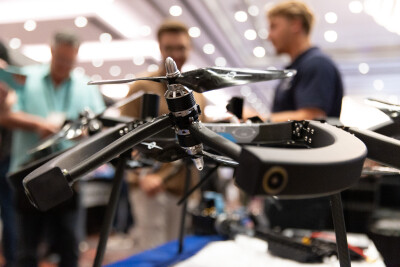Christoph Held demonstrates the IMAGER 5010X and Scout tablet software.
In a SPAR International pre-conference session on Monday, Zoller + Frölich announced their newest 3D laser scanner, the IMAGER 5010X, and its accompanying tablet software, LaserControl Scout. According to the company, the combination of the two products “results in a totally new laser scanning workflow” that allows users to perform automatic registration in the field as they scan.
During the session, Christoph Held of Z+F explained that this workflow was designed to eliminate the problems of missing data by letting you use the Scout tablet software as you scan to verify that your scan has been completed properly. “This is our new ‘blue workflow,’ as we call it,” Held said, “instead of going home and doing everything in the office, why not do everything in the field?”
Using the two products together, he said, “will allow you to automatically register your data in the field, it will allow you to check your data for completeness, it will allow you to check your targets, and you can find gaps in your data and fill them in with more scans.”
Held noted that the 5010X is capable of performing this automatic field registration in part because of its navigation system, which works both outdoors and indoors. “While you are carrying the scanner from one setup to the next one, it will track your movement and try to estimate your position and the orientation of the scanner on the next setup. And this information will be used by the registration algorithm as an initial alignment for the registration. Then the software will automatically do the final registration.”
The Scout software allows you to check your work live in the field. It allows on the fly communication with the scanner and Held said that it can download a scan in a number of seconds over wifi. Any scan data gathered will be synchronized between the scanner and the tablet and stored in both locations. In case you need to swap out your tablet halfway through a job, Held explained, all the data will be downloadable from the scanner onto a second tablet.
Other benefits of the Scout software include the ability to remotely scan, and to sub-select areas of a scan to re-scan them at higher resolution. “Let’s say you want to acquire a target from a much farther distance,” Held said. “Just put a rectangle around it and say ‘scan again’.”
Another time-saving measure, Held explained, is the way the navigation system will work together with the software to automatically sequence scans without any user input.
An unexpected benefit of this workflow is that it gives users something to do with downtime in the field. “Before scanning was pretty boring–you press a button and then you hide for a couple of minutes somewhere else. And now you can actually check your data in the field, you actually have something to do.” Rather than spending your time on registration in the office, he said, just do it as you go. “The download of the data to the tablet is much faster than the time it takes to do your next scan.”
The session was cut short so that Held could demonstrate the 5010X scanner and Scout. He took a very quick scan of the hallway we were standing in and then lifted the scanner off of its tripod and directed for the group to look at the blue dot. He explained that this is where the scanner’s navigation system estimated its position to be using a GPS and other sensors, including gyroscopes and magnets. As he walked around, the dot moved.
Next, he pulled up Scout on his tablet and showed us a series of scans taken in the nearby conference center. The scans were partially aligned by the navigation system but not perfectly flush. He applied the auto-registration algorithm, and within a second or so the scans were aligned. The benefit doesn’t just come from the hardware, and it doesn’t just come from the software, he reminded us–it’s the way they work together.
See Z+F in their booth at SPAR International for more information.






